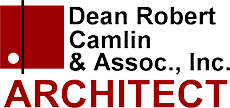
Dean Robert Camlin & Associates, Inc.

Got a question? Our Maryland architecture firm has the answers!
Often people wanting a new house or looking to make changes to their existing home will contact a builder first. But for those who want a unique response to their goals in a dwelling, an architect can offer an inspiring and thoughtful design solution, tailored to their specific needs and budget. For those who haven’t hired an architect before, we offer the following guide:
Tips for Hiring an Architect:
A: Absolutely! Architects share a love for designing functional, attractive, structurally-sound, buildings, but that doesn’t mean that each professional is exactly the same in work style and capability. Your project is unique and you will benefit from talking with multiple architectural experts, as it will allow you to compare design styles, pricing, expertise, and professionalism to find one that is most fitting for your project.
In addition, you’ll be working closely with your architect during the design process and it’s helpful to find someone you can freely communicate with so that you can avoid any misunderstandings when explaining your needs and desires for the project.
A: When it comes to your project or idea, you should be prepared to provide your architect with as many details as possible.
Most importantly:
- Site Information, via a topographic boundary survey or an Environmental Site Delineation
- Project Program – a statement describing what you’d like the design to accomplish
- Budget – the amount of money you either desire or are able to spend on the project.
For architectural projects involving existing buildings, the original construction documents can be highly valuable to your architect and therefore, beneficial for your budget as well. If this documentation isn’t presented, your architect will have to take extra time to carefully inspect the measurable geometry of the building and draw up their own documents to ensure that the existing structure is safe and stable to build on and that the new structure is designed properly given the construction quality of the original building. Providing this important documentation to your architect upfront will save you from paying extra fees due to added work your architect would be required to do to verify the exact size and stability of the existing structure. If you do not possess measured drawings of your house or building, we will have to make them.
If you want to make your own measurements, Click here for instructions.
The Architectural Process in Maryland:
- The type of services you need (i.e. design, bidding, construction administration, etc.)
- The complexity of the building or structure to be designed.
- The amount of work and time your project requires from your architect.
A: Your project has many aspects that are considered when drawing up an estimate for the total cost. The primary factors that determine how affordable or costly your project will be are:
- Style of architecture
- Size of project/building
- Location
- Specific requirements or features
Our architects will work with you to design a project that fits your budget and accomplishes all of your intended goals. We advise our clients to always set aside a portion of their budget for unforeseen situations, like harsh weather, latent conditions, or last-minute changes or updates to your project’s design. Our experts suggest assigning 3% of your new construction project budget and 10% of your renovation project budget for these types of circumstances.
A: Your project will fall under one of the following categories:
- Design-Build – Projects where you only hire one entity (builder, architect, or joint-venture) to handle both design and construction.
- Design-Bid-Build – Projects where the client hires the architect or designer to develop plans, the design is presented to qualified builders, and the winning bidder is assigned to then build the project.
- Negotiated-Bid – Projects where the builder is hired before any other professionals and they are responsible for working with the architect during design phases to ensure the budget is not exceeded.
Maryland Architecture Project Specifics:
A: Our architectural designs meet or exceed the codes published by the International Code Council and the National Fire Protection Association, as adopted to form the Maryland Building Performance Standards. We will assist you in speaking with the appropriate authorities in order to ensure your building idea is up to code and will make site visits as your project is in construction to confirm that those standards and codes are being adhered to.
A: We prefer to lower our impact on the environment when we build, and always keep your energy efficiency in mind when designing any type of building. We promote passive solar heating by choosing an optimal orientation for the building in relation to sun exposure.
Dean Robert Camlin & Associates can additionally suggest ways to lessen water consumption levels and will choose the most durable and low-maintenance building materials for your project in order to leave you with a stable and energy-efficient final product. We can also help in the evaluation of lighting and mechanical systems including geothermal heat pumps, windmills, and solar water heaters.
A: The specialized care and attention we give to each project are vital since every site has its own uniqueness and a one-size-fits-all design plan is typically not appropriate for the projects we take on. The environmental and landscaping factors that are considered when we design Maryland architectural project are:
- Wilderness and Mountainous Terrain
- Moderate Economic Climate
- Farmland
- Urban Neighborhoods
- Downtown and Historic Areas
- Moderate Weather – experience all four seasons, rarely experience hurricanes, flooding, etc.
A: The first step in making a bedroom addition is to confirm with local authorities to ensure that what you have in mind is allowed in your city. If your site is not served by public water and sewer, the Environmental Health Department should also be contacted to confirm that your current septic system can accommodate the additional residents or guests who will be using the new bedroom. Check local zoning laws and share your plans with a zoning officer and make sure the addition will not be breaking any regulations.
A: Mistakes happen, and although we have checking systems in place and BIM (Building Information Modeling) software that helps to minimize errors, blueprint mistakes are still possible albeit infrequent. Here at Dean Robert Camlin & Associates, we provide construction administration services to our clients in order to quickly resolve these errors if they occur and we maintain professional liability insurance to cover the costs of correcting any mistakes.
Terminology in Architecture:
A: Blueprints are the drawings created as a plan or map for the construction of a new building. They generally consist of floor plans, cross-sections, and exterior elevations, but may also include:
- plumbing systems
- mechanical systems
- structural foundation and framing
- lighting and power
- custom work
- site-development design
A: A drafter is someone who might have a general knowledge of architecture but is unlicensed and may or may not have the experience required to design structures to the standard expected of an architect. An architect is a licensed professional who has completed what we refer to as The Three Es:
- Education – Degree from an accredited architectural school.
- Experience – At least 3 years of working under a licensed architect.
- Exam – Passing the Architect Registration Exam.
A: Punch-outs occur once a builder informs your architect that the building or project is ready for occupancy. During this part of the construction phase, we will review all aspects of the project and list any items that require remedial action before the project can be deemed complete. Any final payment to your builder is typically delayed until the architect’s punch list has been completed.
